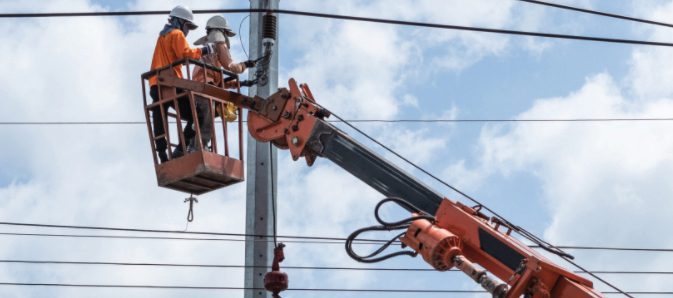Forces of Nature Demand Better Workforce Management
Entergy, the largest utility in Louisiana, was faced with the massive task of repairing some 30,000 poles, 36,000 spans of wire, and 6,000 transformers that were damaged when Hurricane Ida hit the state in September. The utility dug deeply into its mutual assistance networks to summon 27,000 workers from 41 states to join the restoration effort. And still, some of the company’s customers reportedly remained without power almost a month after the storm hit.
It’s not hurricanes but another climate change-related threat—wildfires—that is prompting Pacific Gas & Electric (PG&E) to push forward with a similarly labor-intensive initiative. This past summer, the Northern California utility announced plans to put underground about 10,000 miles of electric distribution power lines, part of a wildfire risk-mitigation effort that involves partnering with material suppliers, contractors, and other utilities that provide internet, phone, and natural gas service.
As heavily as utilities tend to rely on supplemental workers—contractors (Figure 1) and workers on loan from other companies can at times represent 70% to 80% of a utility’s total workforce, according to the non-profit Center for Energy Workforce Development—it’s critical that they have a flexible and highly responsive workforce management strategy, with digital capabilities that enable them to both proactively and reactively scale up, scale down, and mobilize core and contingent workers. In particular, with climate change impacting their businesses and their workforces more than ever, utilities need the ability to seamlessly integrate, monitor, connect and communicate with, coordinate, and securely share information with their own workers, as well as supplemental workers, during an emergency and during the regular course of business.
 |
|
1. Utilities regularly use contract workers to supplement their own employees, often in the field to perform maintenance and repairs, particularly in the effort to restore power after extreme weather events. It’s important that utilities have systems in place to securely provide network access to other utilities and workers to share information without exposing proprietary data. Courtesy: SAP |
Capabilities like these are all predicated on the utility having a cloud-based platform that’s accessible to partner entities outside company walls. To fully leverage their mutual assistance networks (Entergy is part of four of them), utilities need to be able to securely provide network access to neighboring utilities in order to share vital information about their system assets and outages, in real time, without exposing proprietary data.
Giving supplemental workers visibility into current conditions across the system, along with resources (such as schematics, Global Positioning Systems or GPS info, and asset documentation) to help them repair or replace specific assets, speeds the process of bringing extra crews online. From this intelligent platform, all the relevant parties can gain a shared view into what’s happening across the system, ensuring they get the relevant information they need, such as work orders and safety information, in a timely fashion. Such a platform also can function as sort of a “control tower,” whereby a utility can view conditions across its system, then deploy teams based on that situational awareness. To protect sensitive information, companies can make it available only via the cloud, and only by permission, so workers aren’t storing information on their mobile devices, where it’s more of a cybersecurity risk.
Mobile-enabled, in-the-moment network access and support for workers in the field are a must in responding to a climate-related disaster. Crews and engineers in the field need the ability to access system data and other critical information from the cloud in real time, via a tablet or other mobile device, so they can take rapid action. Using a mobile app, they could, for example, access virtual reality tools in a digital twin environment to walk them through the repair of a specific asset, get additional “live” coaching on the repair from an actual human being, if necessary, and communicate the progress of their work in near real-time.
PG&E’s undergrounding initiative is the type of labor-intensive, proactive infrastructure project that can really benefit from advanced modeling capabilities such as digital twins. Using its own system data, as well as data sourced from nearby pipeline operators, internet and phone providers, and others, PG&E could develop plans for locating underground electricity infrastructure in existing rights-of-way used by those other infrastructure providers, then deploy the right workers—contractors and their own employees—accordingly. For such an approach to work, the utility also will need cloud-based workforce management tools that are tightly integrated with work order, human resources, and payroll processes, to ensure appropriately skilled workers from multiple organizations are dispatched to the correct locations, and to manage payroll for disparate payees.
With the ability to collect operational and situational data remotely from Internet of Things-connected assets (such as transformers), then analyze that data using machine learning- and artificial intelligence-powered predictive analytics tools, utilities can deploy workers where they’re needed most, and address issues like an overheating transformer before it becomes problematic. Once an issue is identified, such a system can automatically generate a work order, promptly send it to a crew leader’s mobile device, and quickly initiate a fix.
Technologies like this aren’t just a figment of the imagination—they’re in use today, giving utility companies the digital workforce management capabilities they need to reckon with the very real threats that climate change poses to their assets and the quality of service they provide to their customers during a disaster and otherwise.
—James McClelland is the senior global director of SAP Industries—Utilities.